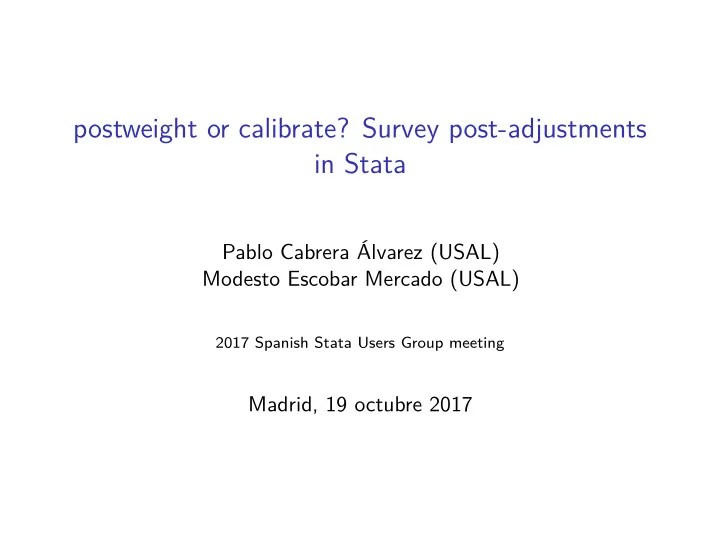

postweight or calibrate? Survey post-adjustments in Stata Pablo Cabrera Álvarez (USAL) Modesto Escobar Mercado (USAL) 2017 Spanish Stata Users Group meeting Madrid, 19 octubre 2017
Survey post-adjustments ◮ Non-response and coverage errors affect survey estimates ◮ Some population members are not in the sample frame (e.g. households with no internet connection in CAWI) ◮ Respondents may differ from non-respondents on key characteristics ◮ Weighting (e.g. postestratification, calibration) is a form of post-adjustment that aims to rebalance the sample using auxilary information (Biemer & Christ, 2008)
Postestratification and calibration ◮ Both methods use auxilary information in order to force the sample distribution to match the population on key auxilary variables ◮ “Postestratification could refer to any method of data analysis which involves forming units into homogeneous groups after observation of the sample” (Smith, 1991) ◮ Calibration doesn’t include any or some of the interactions; It is a relaxed form of postestratification (Zhang, 2000; Särndal, 2007)
Postestratification in Stata ◮ svyset is the Stata command for complex survey analysis and it allows to compute postestratification weights in the background: svyset, poststrata (varname) postweight (varname) ◮ poststrata refers to a variable which identifies the cases in the same poststrata ◮ postweight refers to the population size of each poststratum ◮ The poststratification weight is computed for each estimate based on the sample of valid cases
Calibration in Stata ◮ calibrate (D’Souza, 2010) is a command to compute calibration weights: calibrate, marginals (varlist) poptot (matrix) entrywt (varname) exitwt (varname) ◮ The calibrate command generates a calibration weight which forces the sample to match the population distribution on the marginals variables ◮ The survey estimate is computed each time applying the weight svyset , [ pweight = calibwt ]
Data and methods ◮ Barometer 3183 (July 2017) from Centre for Sociological Research. Multistage clustered sample. Age and sex quotas to select final respondents ◮ Information about past vote and voting intention available; those with no valid past vote were excluded ◮ Three steps: 1) Rebalancing the sample to match the 2016 election results; 2) Estimating voting intention variables using calibration weights and svy poststratification; 3) Comparing estimates
Postweight vs calibrate on auxilary variable Past vote estimate using postweight and calibrate (%): Past vote 2016 elec. Raw wt Postwt. Calib. PP 22.95 23.54 22.95 22.95 0.98 PSOE 15.74 22.08 15.74 15.74 0.71 UP 14.71 16.97 14.71 14.71 0.87 Cs 9.08 9.49 9.08 9.08 0.96 ERC 1.83 2.92 1.83 1.83 0.63 Another party 5.53 8.62 5.53 5.53 0.64 Didn’t vote 30.17 16.38 30.17 30.17 1.84
Postweight vs calibrate on target variables (I) Raw (%) Postweight (%) Calibrate (%) Would vote 84.95 79.64 79.64 Wouldn’t vote 15.05 20.36 20.36
Postweight vs calibrate on target variables (II) Raw (%) Postweight (%) Calibrate (%) Diff. PP 25.60 26.64 28.37 -1.73 PSOE 29.69 27.46 26.90 0.56 UP 20.71 20.42 20.91 -0.49 Cs 14.16 16.82 16.12 0.70 ERC 3.87 2.77 2.94 -0.17 PDCat 0.85 0.83 0.66 0.18 PNV 1.37 1.28 1.02 0.26 Another party 3.75 3.78 3.09 0.69
Comparing weights Calibrate wt Postweight wt Past vote (full sample) (if vote) PP 0.98 0.87 PSOE 0.71 0.64 UP 0.87 0.76 Cs 0.96 0.90 ERC 0.63 0.53 Another party 0.64 0.84 Didn’t vote 1.84 3.12
Wrap-up ◮ Both Postweight and Calibrate are tools for rebalancing the sample ◮ Postweight works in the background recalculating the weights for each estimate based on the valid sample but the same population totals; Calibrate computes a weight to force the sample to match the population, this weight is used for estimates ◮ Postweight can only be used for general sample estimates while the weight produced by Calibrate can be used for general and subsample estimates ◮ The estimation procedures using Postweight [ svy poststrata and postweight options] or Calibrate [ svy pweight option] lead to different standard errors
Syntax (I) ** Preliminar scalar Population = 34596892 matrix Weights = (7941236, 5443846, 5087538, / // 3141570, 632234, 1911558, 10438910) matrix colnames Weights= PP PSOE UP Cs ERC / // Others DontVote matrix rownames Weights=Population
Syntax (II) ** Postweight gen poptotal = 0 foreach num of numlist 1/7 { replace poptotal=Weights[1,`num'] if VarPost==`num' } svyset _n, poststrata (VarPost) postweight (poptotal) svy: prop Variable
Syntax (III) ** Calibrate (I) quietly: sum VarPost gen start = Population/ r (N) tab VarPost, gen (ValuesPost) calibrate, marginals (ValuesPost1-ValuesPost7) / // poptot (Weights) ent (start) exit (wtcal) method (logistic) svyset cues [pweight=wtcal] svy: prop Variable
Syntax (IV) ** Calibrate (II) quietly: sum VarPost if demost == 1 gen start2 = Population/ r (N) if demost == 1 calibrate, marginals (ValuesPost1-ValuesPost7) / // poptot (Weights) ent (start2) exit (wtcal2) method (logistic) quietly: sum wtcal2, d replace wtcal2=wtcal2/ r (mean) svyset cues [pweight=wtcal2] svy: prop Variable
Bibliography Biemer, P. P., & Christ, S. L. (2008). Weighting survey data. International handbook of survey methodology, 317-341. Chicago D’Souza, J. (2010). Calibrate: a Stata Program for Calibration Weighting. London: Stata User Group. Särndal, C. E. (2007). The calibration approach in survey theory and practice. Survey Methodology, 33(2), 99-119. Smith, T. M. (1991). Post-stratification. The Statistician, 315-323. StataCorp. (2015). Stata 14 Base Reference Manual. College Station, TX: Stata Press. Zhang, L. C. (2000). Post-stratification and calibration a synthesis. The American Statistician, 54(3), 178-184.
Recommend
More recommend